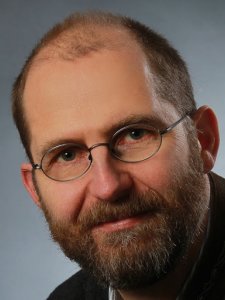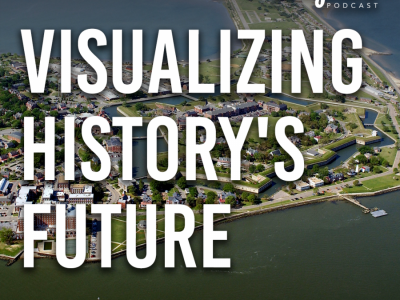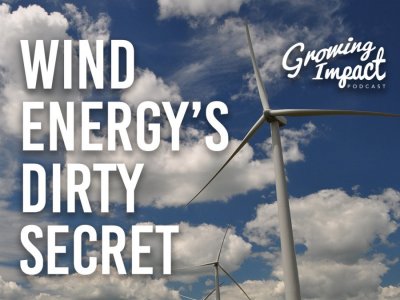In order for the world to meet the challenge of climate change, decarbonization and negative emissions must be part of the discussion. Wei Peng looks to provide policy and tech leadership with information on what decarbonization technology might be effective in the future and how to strategically employ it.
Transcript
INTRO: We have been working in the climate space for quite some time now and I have to say it wasn’t until the past five years or so that I started to realize that more and more people are caring about negative emissions, which is promising. So because now we're now talking about reaching that, stabilizing the emissions. We're talking about achieving negative emissions. To me, that's really a step forward in seriously tackling this global climate challenge.
HOST: Welcome to Growing Impact, a podcast by the Institutes of Energy and the Environment at Penn State. Growing Impact explores cutting-edge projects of researchers and scientists who are solving some of the world's most challenging energy and environmental issues. Each project has been funded through an innovative seed grant program that is facilitated through IEE. I'm your host, Kevin Sliman. Today on Growing Impact, I speak with Wei Peng, an assistant professor of international affairs and civil and environmental engineering. We are speaking about her project that aims to provide policy and technology leaders with information that will help them determine what decarbonization technologies might be effective in the future and how to strategically employ those technologies.
HOST: Welcome to Growing Impact. Today we're speaking with Wei Peng, and we're discussing her project, “From Local Health to Global Climate: Assessing the Impacts Of Early Adoption on the Future Landscape of Negative Emissions Technologies.” Welcome to the episode, Wei.
Wei Peng (WP): It's a pleasure to be here.
HOST: Let's talk about your project.
WP: So we know that climate change is a global issue, but at the same time, how we use energy and how we tackle climate change is also going to affect local health. So one such example is through, for example, air pollution pathway or through food-related health risk. So what we really want to do here is that by understanding what will be the local health implications of these negative emissions technologies—how these local health implications will affect the early adoption of certain technologies, and as a result of changing the future landscape of deploying this technology. So that's really how we want to make this connection between local health and global climate.
HOST: So how are you assessing local health?
WP: The way we do it is through what we call integrated assessment modeling. So this is the kind of modeling approach we have done a lot in the past ten years or so. By linking really interdisciplinary modeling from different aspects. So we usually start with the future socio-economic development, the future population patterns. And this will affect how much energy demand people would need. And this will also affect what kind of energy technologies you want to use in order to meet that demand. And then how we use energy and also how we get our food is going to affect the carbon emissions as well as air pollutant emissions, as well as what I mentioned earlier, those like food-related health risks. So the last component of the integrated assessment modeling is to do a health impact assessment based on your exposure to air pollution and also the exposure to dietary-related risk.
HOST: So you're trying to understand each one of those and how they flow through each other to ultimately impact emissions.
WP: Exactly. So this is really a key, we will say like intellectual contribution we want to make here in order to really connect all these components like technology, like carbon emissions and health, you really need a systems approach. So you will not be able to just use one model with one dataset to answer this question. So what we really want to achieve in this project is to combining though all of those elements, combining the human system, the technologists system, the carbon emissions, and also the health impact so that we can provide a systemic overview of the whole system and how things interact. And this will have again implications on our technology choices, our health future as well as our climate future.
HOST: Okay, so that's the ultimate goal then is to help inform future decisions.
WP: Yeah, we really want to inform the decision on, in this case, the negative emissions technologies so that we can have this integrated view on health and climate and also on cost, economics.
HOST: With emissions, is it something specific that you're looking at, or is it a broad spectrum of emissions?
WP: We definitely care about carbon emissions, right? At the end of the day, carbon emissions are why we have the global warming or climate change problem in the first place. So carbon emissions are definitely one of our focus. But at the same time, as I mentioned, a lot of like energy technology, they not only emit carbon emissions; they also emit air pollutant machines such as sulfur dioxide and nitrogen oxide. So we also focus on those air pollutants as well. And the main reason is that those air pollutants will affect your health. So when they're emitted into the air, they're going to form what we call secondary pollution, such as ozone, such as pm2.5, those like fine particulate matter so small they can penetrate into your lung and pose a health impact. So in addition to carbon emissions, we also capture this kind of air pollutant emissions so that we can really understand the near-term implications for human health. We have been using this model to generate what we call large-scale scenario examples. So we generate like, like 20,000 scenarios so that we can capture a wide range of possible futures. So there will be, we don't know, like, how many people will live on the earth in the future. We also don't know how much energy demand we’ll have in the future. If we have another COVID, some things may change as well. So we want to capture a wide range of plausible futures using this in our example approach. So that's basically where we are.
HOST: Wow, 20,000, I mean, that's, that's mind-boggling to think of so many variables that could be our possible futures. That's astonishing. How, I don’t know if this is relevant or not, in the modeling, and maybe that's what you're aiming for, how—I'll use the term reliable, but maybe that's the wrong term, or how predictive is it or have you seen, do you have ideas of how well the modeling can assist in making these decisions?
WP: Yeah, so I think that's a great question. I think most modelers will answer this question by saying, you know, all models are wrong, but some are useful. And I think I will not say we're trying to make predictions for the future. And to be honest with you, I think anyone who says that, we need to question whether or not he or she can actually deliver that. So what we want to do is exactly, in addition, to say like how confident we are about the future, how about we just take a step back and said that we don't really know, but we know that there are some major uncertainties that will likely shape the possible futures. So as a result, the approach we are taking is not to tell you that these are the two futures that are most possible to occur. Well, the approach we take is that we think there are, for example, 20 factors that are most likely to shape our collective future. And we want to sample all these factors and then just show you those 30,000 possible futures and see whether or not they will be robust strategies that no matter what uncertainties we will face in the future, they are still good things to do or good policies to implement today. So I think robust is really the word we want to emphasize here. We want to identify robust strategies that will do well under a wide range of possible futures.
HOST: Can you talk a little bit about your background in it and then the folks that you're surrounding yourself with to help round out the team?
WP: Yeah, definitely. So most of my work has been looking at the air quality and health implications of energy strategies. So that's the thing I’ve been doing for the past 10 years. So I do things like air quality modeling emissions scenarios. I do health impact assessments. So that's kinda like the academic work I've been working on in the past decade. And that's definitely not enough. As you can hear that I'm talking about a few keywords of our title, but not all of them. I have been really enjoying this collaboration with my co-PI, Dr. Klaus Keller, who's a professor in the Department of Geosciences. He's really an expert on robust decision-making. So this is where the word robust comes into the proposal and comes into our work. So with his help, we have been really thinking hard about, is how to design that, how to sample uncertainties. On the one hand, real, practical, and on the other hand, an important way. And at the same time, after we have this like 30,000 plausible futures, what kind of methodology? So what kind of insights we can get out of it? So this is really kind of like a sweet spot where like I have been really looking at the methodology or the issue connecting energy, health, and climate. And he has been really looking at like really looking out, for example, the uncertainty characterization. And how should we think about robust strategy given that nobody really knows what kind of future we’ll end up with in the end.
HOST: What kind of either organizations or individuals do you hope to help educate, inform, or raise awareness with this information? Who do you hope to deliver this to and who could it impact?
WP: Yeah, that's a good question. So I think what we do is really policy-relevant research. So just to give you some examples, I think now in the United States, so Biden has done really interesting stuff already about the infrastructure plan. But in addition to all those exciting stopped now happening at the federal level, what we have been observing in the past five to ten years is that a lot of climate action is going local. And for example, State College, Penn State University, we do have a lot of climate action that we're thinking about doing locally. The emphasis on local health is really how we want to connect with those local and regional decisionmakers. Because health is the thing that people care a lot about. And we know that climate change needs collective action from everyone in all the locations and also internationally. So I think the targeted audience of our work is really these local decision-makers who hopefully care about global climate change, but at the same time, they care so much about the health of their local communities. So what we want to emphasize here, using the research and insights from our work is whether or not we can find the sweet spot for local decision-makers they can really generate the local health benefits, but at the same time contributing to this global effort of tackling climate change. So I think they are our target audiences in terms of the policy space. I also think that we haven't talked much about the technology aspect. But when are we thinking about things like negative emissions technologies, there are a lot of different potential technologies that can deliver negative emissions. There are technologies that we have been doing for a very long time, such as reforestation. Because when you plant trees, when they grow they draw CO2 from the atmosphere. So That's a thing we have been doing for a long time. There are also other technologies that they are components of them, that we know how to do it, but not the other parts. And in this category, the example is bioenergy with carbon capture and storage. So this is an integrated technology system. Well, we know is, we know how to produce biofuel. But we don't really until now we're not very good at doing carbon capture and storage (the CCS part). So this is the kind of technology backs that there are certain component that is already commercialized, but there are certain components such as CCS which is still struggling to make it a commercializable technology. So this is the second type of technology, and there is a third type of technology that is still really, really early, such as direct air capture. So that's the idea of you directly absorb CO2 from the atmosphere. Right now there are people really using very creative methods to think about how can we do that. But I have to say this is really still in the experimental and research stage. So as you could probably have already recognized, they have, we have different technologies that we could potentially use to reach negative emissions. And they are at different readiness levels and they have different costs. So when you're thinking about which technology you want to invest in as a policymaker and you have the limited funding. And as a technologist, you probably want to be strategic in terms of what technology you want to invest today so that you can secure your market in the future. So I think another targeted audience, we were thinking about those people who are interested in negative emissions technologies and their potential futures. So what we want to really understand here is that because health is important, you know, you could imagine that those negative emissions technologies that have health co-benefits, people may like it better. People may want to deployment, deploy them earlier. As a result, if you choose certain technologies to deploy today, it may make them cheaper and more competitive in the future. So we actually to some extent, help to pick the winners for the future landscape of negative emission technologies. So I think this is kinda like the second type of audience we hope to reach those people who are looking at what kind of negative emissions technologies the society would depend on the future. And also, how should we be strategic in choosing an investing certain technologies?
HOST: That is a heavy burden.
WP: I know, yeah, That's what keeps me awake at night sometimes.
HOST: It's important work that needs to be done, but you're right. If investing or going in a certain direction and then we start choosing those technologies. There's a lot at stake.
WP: So this is also the reason why, remember, we talked about this like a wide range of plausible futures. This is also why I think that dynamic perspective and robustness perspective is critical, right? Because like what you do today is going to affect what will become competitive in the future. So that's why we don't just want to tell you this is like one predictive future. We want to let you know that, for example, if you decide to investing bioenergy with carbon capture and storage today because they can bring certain, for example, health co-benefits. Then this will affect what will be the better strategy for you, like five or ten years or even fifty years from now. So that robust and dynamic perspective is what we want to add to the literature in this space.
HOST: Thank you for listening to Growing Impact. Today we spoke with Wei Peng and we discussed her project “From Local Health to Global Climate: Assessing the Impacts Of Early Adoption on Future Landscape of Negative Emissions Technologies.” Thank you for being here, Wei.
WP: Thank you for the opportunity to chat with you.
HOST: You're very welcome. Thank you for taking time.
HOST: You have been listening to Growing Impact, a podcast by the Institutes of Energy and the Environment at Penn State. I've been your host, Kevin Sliman. This has been season 1, episode 5. Thank you for listening.









